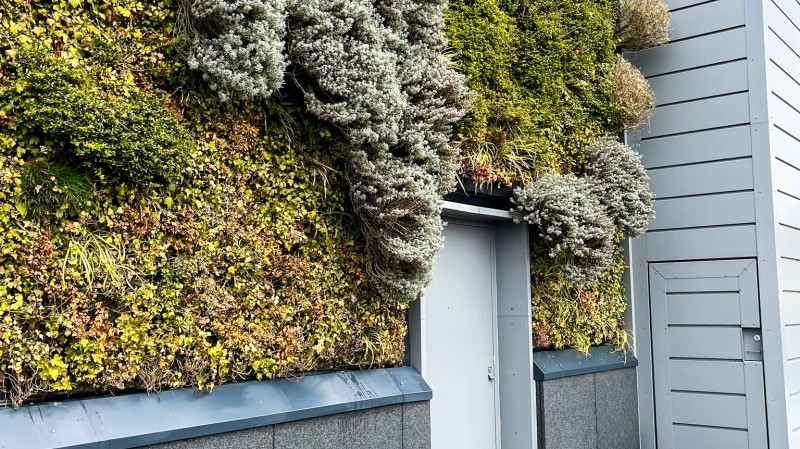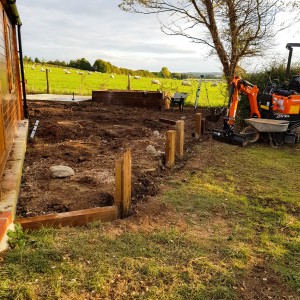You are here: Living Roofs and Walls
Living roofs and walls not only have a striking visual impact, but also a whole host of environmental, economic and emotional benefits. Since living roofs popped up in London’s financial district at the turn of the 21st Century, their popularity has continued to grow; living walls have similarly grown in popularity throughout the 2010s. Once the realm of large, commercial developments with suitably sizeable budgets, they are now becoming popular additions to residential property developments.
Perhaps most importantly, a 2021 RSPB report stated living walls and roofs are key to protecting the UK from the effects of extreme weather associated with climate change, such as flooding and extreme heat. Although the advantages are numerous, there are of course drawbacks to these ‘living’ structures, too. The following article is an introduction to living roofs and walls, their benefits and limitations.

What are living roofs?
Living roofs are made of layers of non-porous membrane, insultation, material for filtering and drainage, root-barrier membrane, and finally a soil substrate. Vegetation is then planted in this substrate, the type and extent of which is determined by the depth of the substrate used. They fall into two main categories:
Intensive:
These are the most high-maintenance living roof. They have deep substrates (usually over 300/350mm) to accommodate larger vegetation, such as small trees, bushes and shrubs. Veritable roof gardens can be created with this type of living roof, but they require maintenance in terms of irrigation, cutting back/pruning and mowing any areas of lawn). As intensive living roofs are used for larger vegetation and require larger depths of soil, it almost goes without saying that these are heavier roof structures than other types of living roof, and the structure below needs to be able to accommodate this load.
Extensive:
They use a thinner layer of substrate compared to intensive living roofs (usually 50-150mm), so the vegetation that can grow on them is relatively light-weight. Sedums, mosses, wildflowers etc. all work well here. Irrigation is not usually needed, and maintenance in terms of cutting back or weeding is minimal. Depending on the aspect and exposure of the roof, ferns and grasses can also work well according to the Royal Horticultural Society, RHS. Due to the type of plants suitable for extensive roofs, they are lower maintenance than intensive living roofs.
Semi-intensive or Semi-extensive living roofs are also options for homeowners or developers wanting to strike a balance between the variety of vegetation on their roof, and its maintenance needs. They usually have soil substrates of around 100-200mm, according to RHS.
Furthermore, blue-green roofs (which integrate a means of temporary rainwater storage amongst the vegetation) and biosolar roofs (in which solar panels are incorporated into the vegetation) are additional types of living roof.
The planning, installing and maintenance of living roofs is covered by the Green Roof Organisation (GRO) Code of Practice, which in turn is largely based on the German (FLL) Green Roof Guidelines (2018).
What are Living Walls?
Living walls are modular systems (Living Wall Systems, LWS) installed on exterior or interior walls; a variety of vegetation is then grown on a substrate within the modules, creating a kind of vertical garden. LWS are different to ‘green walls’, ‘green facades’ or ‘greening’, whereby climbing plants are grown directly onto exterior walls (‘direct greening', i.e. Ivy, or Virginia Creeper) or on a trellis or support (‘indirect greening’, i.e. climbing roses), as LWS can use a broader range of plant species and therefore achieve a different aesthetic than can be achieved by climbing plants alone. What is more, whereas climbers are traditionally confined to exterior walls, interior walls can also be made into living walls.
Living Wall Systems’ modules can be made of a variety of materials, from woods and metals, to plastics or rock wool. Each module contains a substrate for the vegetation to grow on; sometimes this is hydroponic, but it can be also be soil-based, such as clay, sand, chalk or peat. There is usually an integrated irrigation system as well, as watering vertical surfaces can be inefficient. The modules can be affixed to walls, or freestanding.
RHS has a guide to suitable plants for living walls and advice for planting.
What are the benefits of Living Roofs and Walls?
Minimise the Urban Heat Island Effect
Adding dense layers of vegetation to urban environments helps to lower the temperature, minimising the difference between this and the surrounding countryside.This is largely because evaporation of water molecules from plants’ leaves and soil both cools and humidifies the surrounding air, lowering its temperature. Furthermore, the soil substrate of living roofs and walls absorbs some heat.
Reduced urban flooding
Living roofs absorb rainwater, and the plants will reduce the flow of run off. Intensive living roofs have the greatest benefit, as the greater depth of soil can absorb more rainwater.
Air purification
Vegetation helps remove pollutants from the surrounding air and therefore improve air quality. Nature Scot also point out that the vegetation will neutralise the pH of acidic rainwater.
Energy Efficiency
The insulating effect of living walls and roofs means the temperature inside the property is easier to maintain, so the property itself will be more energy efficient and more economical to run. A study by Plymouth University showed living walls can help reduce the heat lost from a building by 30% (Fox et al., 2022).
Boost biodiversity
The shelter, food and nesting site that layers of dense vegetation offer to wildlife is invaluable in environments where green space is minimal. Living Roofs and Walls have the potential to make big strides in terms of Reconciliation Ecology, in boosting biodiversity in spaces which are heavily developed.
Dampens noise pollution
The layer of vegetation will help absorb sound, and so help soundproof a property from the noisy environment outside.
Protects the fabric of the building
Living roofs absorb UV radiation and frosts which would otherwise damage the fabric of the roof, such as felt or rubber; this means a living roof will last longer than a typical flat roof. Similarly, living walls will absorb heat and protect the walls of the building itself from this heat- a layer of protection that is important when the UK experiences extreme temperatures. Living walls and roofs help to minimise the amount of thermal movement in a building itself, in turn minimising the chance of these movements doing any damage.
Health benefits
It is well known that humans are drawn to nature, and our biophilia is evident in the relationship between being around plants and living things and improved mental health and wellbeing. This includes: reduced stress, depression and anxiety, improved self-esteem, productivity and attention (Hall & Knuth, 2019). It is no surprise then that living walls and roofs are popular choices for urban developments, where it is often difficult to maintain this relationship with nature and reap the benefits that come with proximity to plants.
Aesthetic
Unquestionably, living roofs and walls are visually striking. Their visual impressiveness is not limited to properties in built-up urban environments, where the verdant contrast to brick, mortar, concrete and glazing is perhaps most stark. Even in rural settings, where they are surrounded by a good deal of green space, a living roof or wall can tie a property in to its environment and still be impressive in its harmony.
What are the drawbacks?
Cost
One of the main drawbacks of living roofs and walls is that of cost. These systems are not cheap, and property extensions or developments with living walls and roofs will require professional input in terms of design, planning and installation. A Living Wall System or living Roof will need to be designed, engineered and installed by experts, and their fees will of course be commensurate to their expertise. For example, a Structural Engineer might be needed to ascertain whether the structure below a proposed living roof needs to be strengthened before installation. A landscape gardener might be needed to design the planting plan itself. Add to this the cost of the plants, and any machinery/equipment you might need to gain access for planting, and the cost quickly adds up.
To give an idea of cost, the Renewable Energy Hub estimates an intensive living roof can cost around £150/m2, and an extensive living roof around £100/m2.
Careful planning
The roof or wall will need to be designed in such a way as to allow access for maintenance, such as weeding, cutting back, replacing dead plants etc. You will also need to be aware of the effect of wind loading, roof pitch and dead load when planning your living wall or roof, and be aware of the limitations these can place on your plans. For example, a living roof is usually best on a flat roof (usually less than 10’ pitch to avoid the vegetation sloping off). So, a living wall or roof is not necessarily suitable for every space, development or refurbishment.
Planning Policies or Restrictions
It is important to check whether you have the necessary permissions to install a living roof or wall in your property. The project may fall within Permitted Development rights, but it is wise to check with your local planning authority to make sure they do not have any particular restrictions in place; some local authorities have specific guidelines and policies relating to living roofs and walls (i.e. Barking and Dagenham council). Similarly, your building insurance provider will need to know of the changes you intend to make, as will your mortgage provider. Whilst you may not need planning permission, it will still need Building Regulations approval.
High maintenance
A traditional wall or roof of course requires periodic inspection and repair work. Living Roofs and Walls may require more regular maintenance, in terms of cutting back/pruning, replacing plants that fail to thrive or suffer damage, and watering. This maintenance comes at a cost of your time (and equipment, where necessary), or the time/labour of professionals. However, living roofs have a longer life expectancy (40-50 years according to Roofing Megastore) than most flat roofs (10-20/25 years). So, the maintenance might be worth it for the extended lifespan and the multiple other benefits of living roofs.
Can I make my own?
The short answer for both is that, for larger projects (a home extension or annex, for example), you will of course need professional input from an architect, structural engineer, and perhaps a landscape gardener; in the case of living walls, you will need a professionally engineered and installed Living Wall System. You will also need to make sure you have the necessary permissions for the project. Many architects now specialise in eco-homes, and consulting with them would be a good starting point.
However, for small-scale home improvements in the form of, say, a living roof for a garden shed or bike store, or a verdant garden wall, there are DIY-options available:
DIY Living Roofs:
There are numerous guides that can be found online describing how to design and build a small living roof: see this guide from Countryfile, or this one from livingroofs.org. but it is no small undertaking and probably best left to the DIY enthusiasts.
Living Walls:
For ‘greening’ smaller walls or areas of a wall, there are kits available online which allow the DIY novice to achieve a striking effect on a small scale and budget. They are technically more ‘green walls’ than ‘living walls’.
Starting around £20-50, some kits involve a kind of felt pocket network that can be hung from a wall or otherwise screwed onto it; you can then plant plugs into each pocket. For example, this product available online.
There are also kits that are a series of stackable units, made from recycled plastics. Starting around £80 for 3 ‘units’, these can be scaled up or down according to the size of wall you want to cover.
Whilst these won’t achieve quite the same effect as a full scale, professionally engineered, designed and installed Living Wall System, they can still look pretty impressive. You can move plants between pockets or units, or replace them, make your own planting plan based around the pocket or unit system, and generally maintain a small DIY-living wall with ease.
The economic, environmental, social and emotional benefits of living walls and roofs are numerous. Given the climate crisis, threats to UK biodiversity, challenges to mental health and the cost-of-living crisis, you would be forgiven for thinking living roofs and walls were then infallible. There are, however, some key disadvantages which need to be considered in any plan, design or installation you have in mind. The cost involved in professionally designed and installed living wall systems of roofs is considerable. Whilst this cost may be somewhat offset by the insulation they provide and their long lifespan, it is a cost to factor in nonetheless. DIY options are available for small scale home improvements.
If you are looking to make some home improvements, you may find some of these services useful
Garden Design
If you are considering improving your garden
Japanese Knotweed
Is Japanese Knotweed really as bad as you think?
Building Regulations
Find details of local experts who can help with Building Regulations
Builders
Find local help with a building project
Architectural Design Services
Find local Architectural Design experts
Structural Inspections
Find an expert to carry out a structural inspection
Choose which Architectural service you require
If you are not sure which service you require, check out the options available...



